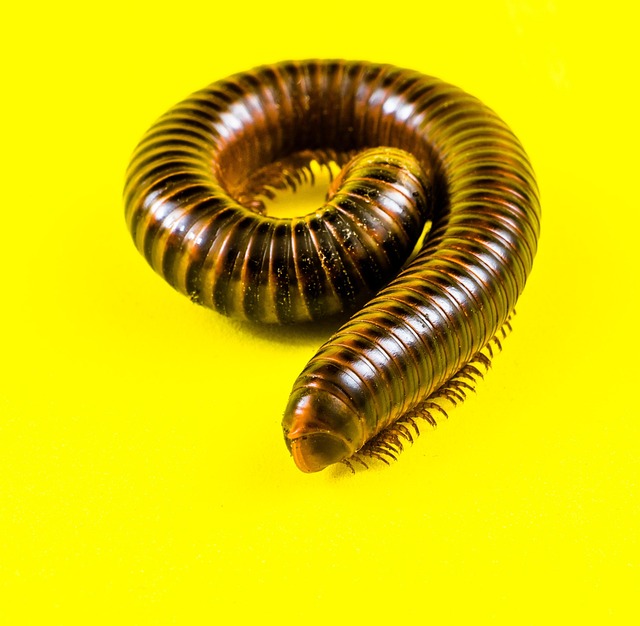Millipedes, though fascinating, are unwanted intruders often found in damp, humid areas like basements and gardens, where they build complex nests and communicate via pheromones. While not posing direct health risks, their burrowing habits can cause structural damage. Modern millipede control services offer eco-friendly and efficient alternatives to traditional chemical pesticides, utilizing heat treatment, vacuum systems, biological solutions, and AI-driven monitoring for early detection. These advanced technologies provide long-term savings and reduced environmental risks, ensuring effective millipede extermination while adhering to best practices in pest control.
Millipedes, though seemingly harmless, can wreak havoc in homes and businesses due to their destructive behavior. This article explores advanced technologies revolutionizing millipede extermination, a significant concern for many. From understanding these creatures’ behavior to examining innovative solutions like heat treatment, UV light traps, and chemical-free options, we delve into the future of millipede control services. Discover how these modern methods offer efficient, safe, and eco-friendly ways to manage infestations.
Understanding Millipedes: Behavior and Habitat
Millipedes are fascinating yet often unwelcome intruders in both residential and commercial spaces. Understanding their behavior and habitat is crucial for effective millipede control services. These creatures prefer damp, humid environments, making them common in areas with high moisture levels, such as basements, crawl spaces, and wet gardens. They are slow-moving and primarily nocturnal, seeking shelter during the day and becoming active at night to feed on organic matter.
Millipedes are social insects, living in colonies that can number from a few dozen to several thousand individuals. They communicate through pheromones and maintain intricate nest structures. While they don’t pose a direct threat to human health, their presence can be a nuisance and even cause structural damage to buildings due to their tendency to burrow into wooden structures, leading to weakened foundations and walls. This highlights the importance of proactive millipede control services for maintaining healthy and safe living or working environments.
Traditional vs. Advanced Extermination Methods
In the battle against millipedes, traditional methods have long been the go-to solution for many. However, with the evolving nature of these pests and the increasing demand for eco-friendly solutions, advanced technologies are now taking center stage in the world of millipede control services. The conventional approach often involves chemical pesticides, which can be effective but come with potential health and environmental risks. These chemicals may also only provide temporary relief, requiring frequent applications.
Advanced technologies offer a more sophisticated and sustainable approach to millipede control. From heat treatment and vacuum systems to biological solutions like beneficial insects, these modern methods are transforming the way we manage millipede infestations. Heat treatment, for instance, uses targeted heat to kill millipedes and their eggs without harming other organisms or leaving chemical residues. Vacuum systems physically remove millipedes from affected areas, making them particularly useful for hard-to-reach spaces. These innovative techniques not only provide more effective long-term solutions but also cater to the growing demand for environmentally conscious millipede control services.
Innovative Technologies for Effective Control
In the ever-evolving world of pest management, advanced technologies are revolutionizing the way we approach millipede control services. Traditional methods often involve chemical pesticides, but these can be harmful to both the environment and non-target organisms. Innovative solutions include the use of biological control agents, such as natural predators or parasites that specifically target millipedes, offering a safer and more eco-friendly alternative.
One promising technology is the implementation of targeted heat treatments. This method utilizes precise temperature controls to eliminate millipedes without damaging nearby structures or ecosystems. Additionally, advanced monitoring systems equipped with sensors and AI can detect millipede infestations early on, enabling swift action. These technologies not only enhance the effectiveness of millipede control services but also promote sustainable practices in pest management.
Benefits and Considerations of Modern Millipede Control Services
Modern millipede control services offer a range of benefits, revolutionizing the way these pesky creatures are managed. Unlike traditional methods, which often relied on chemical pesticides with potential environmental and health risks, contemporary solutions embrace advanced technologies. These include targeted treatments using bio-based agents, heat therapy, and innovative mechanical traps that are both eco-friendly and highly effective. By employing such modern millipede control services, property owners can expect reduced exposure to harmful chemicals and a more sustainable approach to pest management.
When considering these services, it’s essential to balance the benefits against specific considerations. Cost is a primary factor, with advanced technologies sometimes carrying a higher price tag compared to conventional methods. However, long-term savings and the absence of health and environmental concerns make modern millipede control appealing. Additionally, specialized treatments may be required for severe infestations or unique ecological settings, impacting the overall cost. Yet, professionals in this field are adept at customizing solutions to meet individual needs, ensuring effective millipede extermination while adhering to best practices in pest control.
In conclusion, advanced technologies offer efficient and modern solutions for millipede extermination. By understanding these creatures’ behavior and habitat, we can employ innovative methods like heat treatment, chemical free options such as neem oil, and targeted laser technology. These cutting-edge approaches provide significant advantages over traditional methods while ensuring a safer and more environmentally conscious approach to millipede control services.
